Drawing and illustrating in the pre-digital time
Some of the tools described here are still in use – at least in education at school. However, most of the items have disappeared from a professional environment. Even the drawing board has disappeared. But we all are still dreaming of screens of that size!
Most french words courtesy by Daniel Blériot. [2001-12-15]
See also links and my private collection.
| drawing tool, design tool | das zeichenwerkzeug | util à dessiner |
|---|---|---|
Compass |
der zirkel der stangenzirkel der nullenzirkel der fallnullenzirkel der teilzirkel, stechzirkel |
le compas la boîte à compas le compas à verge le compas à pompe le balustre |
| Camera lucida | die camera lucida | le camera lucida, la chambre claire |
| Drawing board | das zeichenbrett die zeichenmaschine |
la planche à dessin la machine à dessiner |
| Drawing instruments | das reisszeug | |
| Drawing pen | die reißfeder die nachlauffeder die doppel-reißfeder |
le tire-ligne le tire-ligne pour courbes le tire-ligne pour double trait |
| Ellipse compass | der ellipsenzirkel | ??? |
| French curve Flat spline Lesbian rule |
das kurvenlineal die straklatte |
le pistolet (à dessin) ??? biegbares kurvenlineal |
| Pantograph | der pantograph, der storchenschnabel | le pantographe |
| Proportional compass | der reduktionszirkel (proportionalzirkel) | le compas de réduction |
| Protractor | der winkelmesser | le rapporteur |
| Ruler Parallel ruler |
das lineal das parallel-lineal |
la règle (de proportions) la règle parallèle |
| Scale | der maßstab | l'échelle [fem.] |
| Slide rule Calculation disk |
der rechenschieber die rechenscheibe |
la règle à calcul le disc à calcul |
| Set square | das zeichendreieck | l' équerre [fem.] |
| Template Lettering stencil |
die schablone die schriftschablone |
??? la trace-lettre |
| T-square | die reißschiene | la règle à dessin |
| Circle drawing tool | der kreiszeichner | ??? |
| X2 | der fluchtpunkt-zeichner | ??? |
![[To top/bottom of page]](../../z_designs/nav-dnup.gif) My private collection
My private collection
Click on image for larger picture

![[To top/bottom of page]](../../z_designs/nav-dnup.gif) Drawing pen
Drawing pen
Early drawing pens were made similar to forceps, with a screw to adjust the distance of the two legs which held the indian ink. I remember the time when the two legs even had to be smoothed with a honing stone to undo the waering from the very harsh paper. For my map drawing I also had a double pen (for streets) and a free wheeling pen for altitude curves (isohypses).
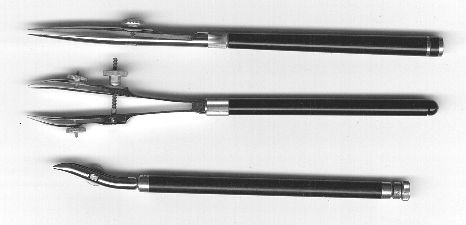
The pen at this drawing fountain pen could easily be exchanged for writing with types for narrow and wide lines.

This was my set of pens for a number of years...
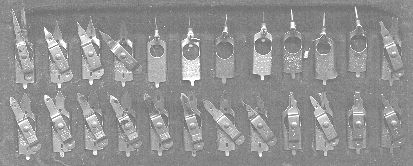
![[To top/bottom of page]](../../z_designs/nav-dnup.gif) Drawing
board
Drawing
board
The most common drawing board for engineers and also for illustrators used a parallelograms to keep the rulers parallel to itself. The detail picture shows the 'head' of the machine: The rulers could be exchanged according to the desired scale; they could also be rotated in 15 degree steps or fixed at an arbitrary angle.
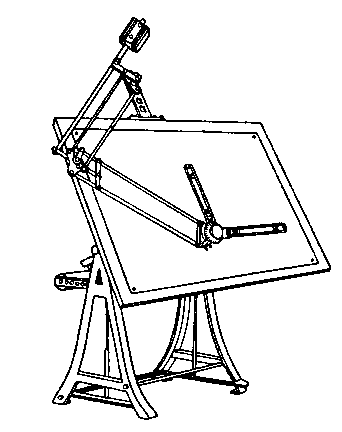
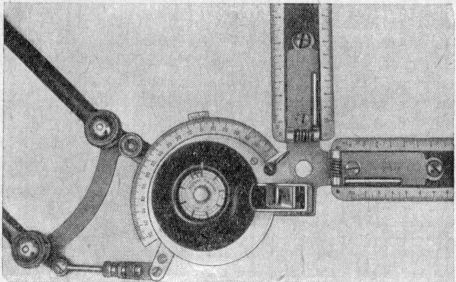
For wide drawing boards (especially used in the ship industy) the parallelogram mechanism was replaced by a horizontal rail on top with a 't-square' on roller barings holding the drawing head.
![[To top/bottom of page]](../../z_designs/nav-dnup.gif) Set square
and T-square
Set square
and T-square
Amateurs and students most time are confined to simple forms of a drawing board with a t-square to draw horizontal lines (the board was not square enough to allow for verticals also). Angles in steps of 15 degrees require 2 set squares with 90-45-45 degrees and 90-60-30 degrees. Arbitrary angles are supported by adjustable set squares.

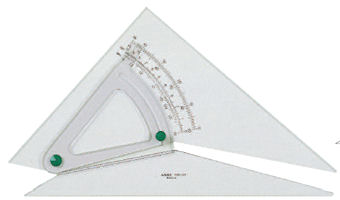
For the desktop A2 and A3 sized drawing tablets became available with a combination of t-square and protractor. I still have an A3 sized in use.
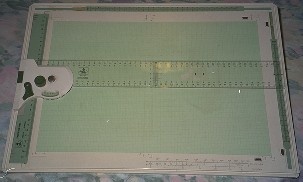
![[To top/bottom of page]](../../z_designs/nav-dnup.gif) Ruler
Ruler
For working on the desk a ruler is still a handy tool. Most time it is combined with a 1:1 scale with tic marks at every mm. For typographic purpose also rulers with pica, points etc. are still in use.
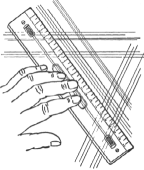 Convenient
tools on the desk are parallel moving rulers. One type has (rubber coated)
rollers to guide the movement. Another type connects two parallel half-rulers
with two legs forming a parallelogram with the ruler.The type with the rollers
often is combined with a mechanism to slip the ruler step be step for hatsching.
Convenient
tools on the desk are parallel moving rulers. One type has (rubber coated)
rollers to guide the movement. Another type connects two parallel half-rulers
with two legs forming a parallelogram with the ruler.The type with the rollers
often is combined with a mechanism to slip the ruler step be step for hatsching.
A more elaborate example is pictured hereafter. This is a multipurpose tool especially for students. Even math formulas and trigonometric tables are available. With the various holes on the long edge a compass can be simulated.

![[To top/bottom of page]](../../z_designs/nav-dnup.gif) Scale
Scale
Since various drawing scales were needed, the tool combined 6 scales, for example, 1:200, 1:50 etc. (metric engineer's scale) or 1:48, 1:128 etc. (imperial). Also very strange scales for rural maps could be found: 1:1440 and 1:2880 (architect's scale).

![[To top/bottom of page]](../../z_designs/nav-dnup.gif) Template
Template
Not only children like templates. Making illustrations on paper very often is faster than any computer based method... A standard catalogue for templates as of 1997 lists hexagons, ellipses, electrical and chemical signs etc. For special purpose lettering stencils are still used.
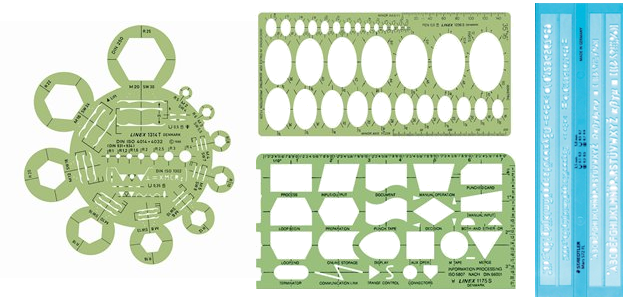
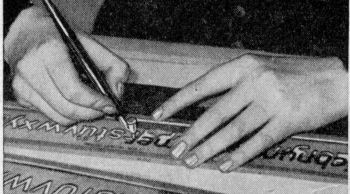
For drawings such as the following I created templates of my own using a 0.5mm plastic foil:
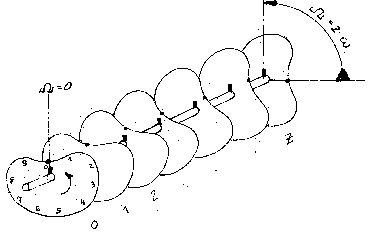
![[To top/bottom of page]](../../z_designs/nav-dnup.gif) French
curves
French
curves
A common set of curves is the Burmester set displayed here. The first item is very handy for ellipses, the second very often fitts large parts of hyperbolas and the third (largest) item is used most for parabolas.
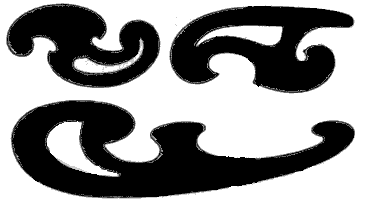 |
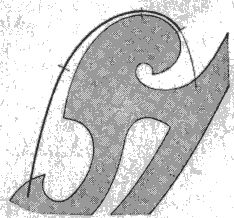 |
During my time as a mechanical engineer I also used a very special courving tool: some sort of plastic snake with lead spine, about 40 cm long. This could be bent to the desired shape.
Flat spline
In ship building where drawings frequently were to the scale (or at least
as large as rooms), another form of curving tools were in use. This is a long straight slat of wood or
other bendable material. It was pinned down along few points shaping the
curve.
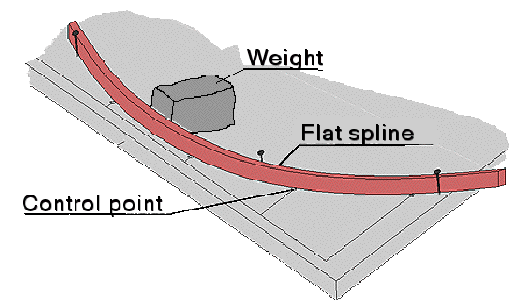
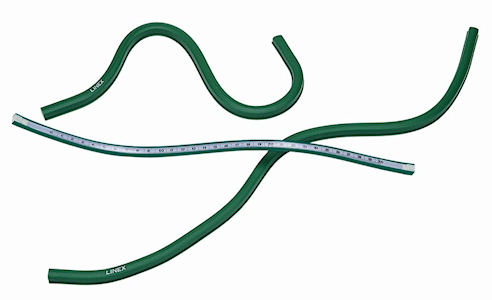
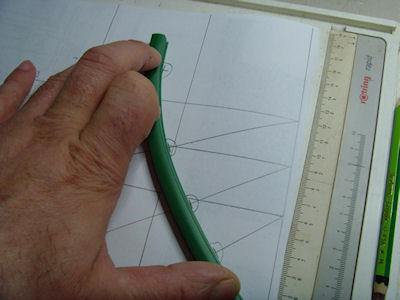
Flexible curve
To adjust to arbitrary curved shapes a flexible rule (plastic with lead spine) is used. This has no inner tension, so control points did not work properly. Sometimes it was called lesbian rule.
![[To top/bottom of page]](../../z_designs/nav-dnup.gif) Compasses
Compasses
Various types of compasses and drawing pens were combined in a box of drawing instruments. The compass in this set could draw circles up to 25 cm in diameter by means of an elongation rod. To draw very small circles a drop compass and a bowcompass is included, sometimes also a divider compass with two pins.
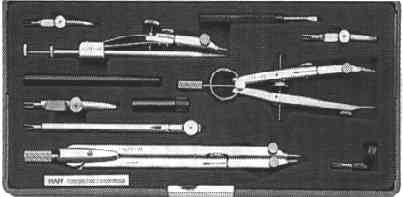
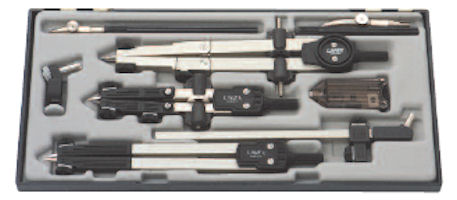
The left picture is the set from my father (about 1930), the right is from the catalogue of
Linex, DK (2015).
Beam compass
For larger circles the needle and pencil are arranged on sliders on a rod or beam, which might also be eleongated. I remember that once we needed a radius of 4m. Kneeling on the floor we just used an ordinary wooden rod of that length. There are however also special instruments to draw large circles.

![[To top/bottom of page]](../../z_designs/nav-dnup.gif) Proportional
compasses
Proportional
compasses
Proportional compasses are used to divide distances or to 'convert' them according to a scale. A specialized device for the relation of the golden rectangle may be still in use by sculpturers and other artists. The rightmost image depicts an instrument to divide a distance into up to 10 equal parts.
 |
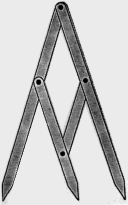 |
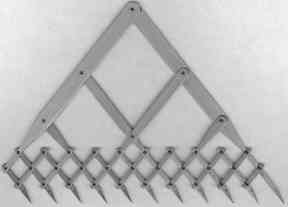 |
![[To top/bottom of page]](../../z_designs/nav-dnup.gif) Drawing
large circles
Drawing
large circles
But how to draw circles, if the center can not be reached? I have only a scetch of such an instrument. There were other types available with greater accuracy, but more elaborate.
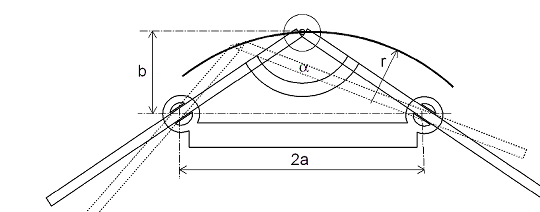
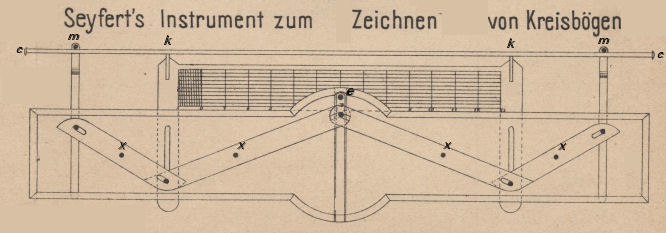
b = r - sqrt(r2 - a2) For a given radius angle alpha
is constant. Because a is an instrument constant, there were tables to get
b from the desired radius. A simple form of this instrument consists only of two streight strips of wood fixed together in the position 1 and sliding at pins A and B on the board.

H. Seyfert patented 1880 an instrument which uses a steel-blade (c-c). It is supported at both ends (m). The arc is created by pushing the steel blade at the position k, while pulling the supports at m. The bending of the steel-blade is perfomed by moving the pin e down. The various levers swing around the index pins x. This is done by turning a disk which has a spiral notch engagend with the pin e. This disk is marked with the radius of the created arc. The graduation starts with 5000 mm and goes (for one turn) to 300 mm. With a second turn a radius of 150 mm can be reached.
![[To top/bottom of page]](../../z_designs/nav-dnup.gif) Ellipse
compasses
Ellipse
compasses
Before you just could drag your mouse to get an ellipsis of any size both templates and special mechanical devices were used. The two devices depicted use different methods of drawing an ellipse.
.jpg) |
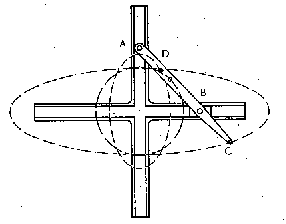 |
The method using a thread is at least still used by gardeners. Using a sharp pencil, thin pins and a thin thread you can get quite a good precision by this method first described at least by Descartes (1596 - 1650):
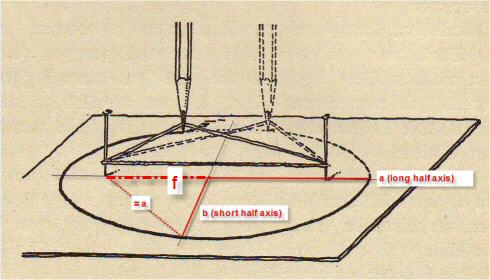 |
Based on the desired long and short axes you can
construct the positions of the focal points where the pins are inserted The length of the thread is |
![[To top/bottom of page]](../../z_designs/nav-dnup.gif) Pantograph
Pantograph
For enlarging and reducing drawings this tool was at least in use by amateurs. Heavy duty models are still in use for engraving and contour milling.
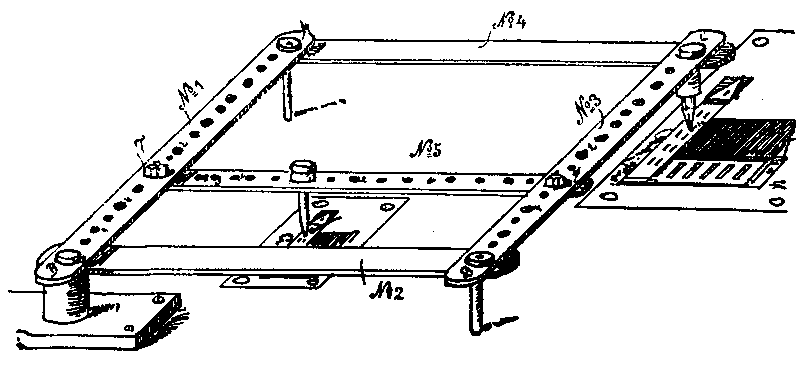
Another form of this tool was called Storchenschnabel in German.
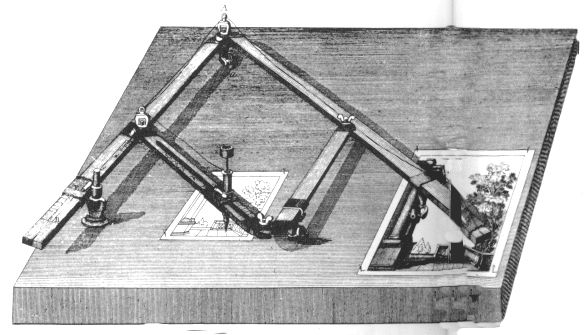
![[To top/bottom of page]](../../z_designs/nav-dnup.gif) Perspective
illustrations
Perspective
illustrations
To draw correctly with perspective using vanishing points wide drawing boards with special rods were used. Let's see, maybe I find a photograph from such a device.
Skilled users could combine photographs with drawn illustrations - a task nearly everybody can perform now with graphic software.
![[To top/bottom of page]](../../z_designs/nav-dnup.gif) Camera
lucida
Camera
lucida
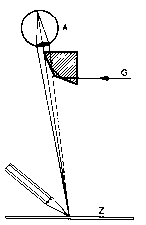 |
You might know the camera obscura, which works only for very luminous situations. Camera lucida (light chamber) was developed by W. H. Wollaston in 1807 to draw landscapes etc. with ease. See also about.com. The main component is a 4-sided glass prism. From the oject G the light is seen by the eye A in Z, where the pencil can be used to draw the object. When the instrument is built with mirrors rather than a prism it is called mirror lucida. The following is a 'folded away' instrument from the 18th century in the catalogue of gemmary.com.
Modern versions of a camera lucida can be purchased (for example) from: camera-obsura-lucida.shop.com (with videos explaning the use) or cameralucida.org.uk, and here a model for less than USD 80.- Some microscope manufacturers also provide "camera lucida mirrors" or "camera lucida prisms" for drawing (rather than photographing) the seen image. For example, Cosmo Laboratory Equipment, Kay Kay Global Suppliers or Kshitij Innovation. |
![[To top/bottom of page]](../../z_designs/nav-dnup.gif) Protractor
Protractor
Various forms are still in use at school. The most used one provides 180°. I still have one with 400g for the full circle (and I also have trigonometric tables for these 'neugrad' or 'new gradation' which allows more easy mathematical handling of arcs). Still available are protractors with 400g (gon) to the full circle. The divison of a right angle into 100 gon, ... allowed more easy calculations in trigonometric tables (decimal system).
For military use 'artillery' versions with 6400 units for the full circle were available (at least in Switzerland).
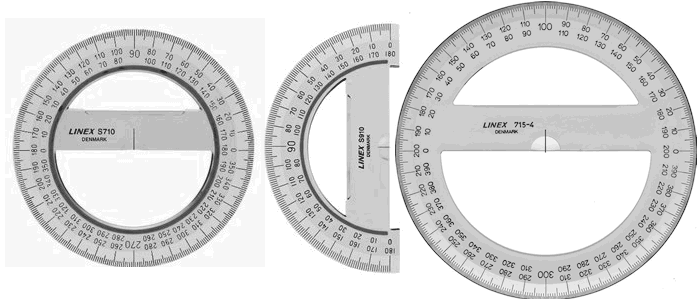
![[To top/bottom of page]](../../z_designs/nav-dnup.gif) Slide
rule
Slide
rule
This is not a drawing tool per se, but was used by educated people for calculations. The analogue calculator is based on the logarithms, discovered (or developed) by Leibnitz, Newton and Napir 1). This principle reduces multiplication and division to addition and substraction. Potenzation and roots are reduced to multiplication and division. But also special scales for trigonometric calculations etc. were in use. The typical slide rule of an engineer had 25 scales and was 25cm long. this allowed an accuracy of 3 - 4 digits.

The sliding window shows the square of 4 (scale D) to be 16 (scale A). The tong shows the multiplication of 1.26 by 3.17 (C) = 4 (D).
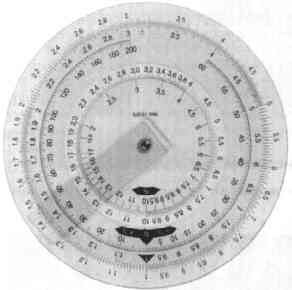 |
'Winding up' the scales on circles allows a high precision even with a small device. Specialised versions of calculation disks are still in use, for example, to calculate settings of machines. |
![[To top/bottom of page]](../../z_designs/nav-dnup.gif) Sources
Sources
Bachmann-Forberg: Technisches Zeichnen; B.G. Teubner; Leipzig
19954 ![]()
A. Gruber: Zeichen- Mal- und Messgeräte, Otto Maier; Ravensburg
ca 1940 ![]()
Denis Diderot: Encyclopédie, ou Dictionnaire des sciences, des arts et des métiers; Paris, 1762 - 1777 (I have only a facsimile of the image tables).
Katalog 894 (August 1994) Racher & Co AG, Zürich.
Meyer zur Capellen, Walter, Mathematische Instrumente. Leipzig: Akademische Verlagsgesellschaft Geest & Portig K.-G, 1947.
![[To top/bottom of page]](../../z_designs/nav-dnup.gif) Links
Links
- Lueger
 Lueger: Lexikon der gesamten Technik (1904)
Lueger: Lexikon der gesamten Technik (1904)- Wikipedia
- Category:Technical drawing
 Kategorie:Zeichenwerkzeug
Kategorie:Zeichenwerkzeug - Camera Lucida, Obscura etc.
- Origin of Shadows by Ross Woodrow, University of Newcastle, Australia.
- Compass, Protractor
- Wolfram Research
 Spezialisierung
und Generalisierung in der Entwicklung
der Zirkel (wenn nicht mehr dort: hier).
Spezialisierung
und Generalisierung in der Entwicklung
der Zirkel (wenn nicht mehr dort: hier). - Drawing tools
- Ecobra GmbH, Nürnberg, Deutschland
Tecnomarket (Italy): Disegno tecnico - Slide rules
- Seite der deutschsprachigen Rechenschieber-Sammler
![[To top/bottom of page]](../../z_designs/nav-dnup.gif) Notes
Notes
1) Of course, the Swiss claim Jost Bürgi to be the discoverer / developer of logarithms...
